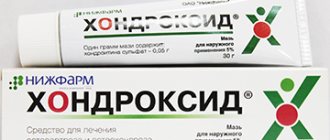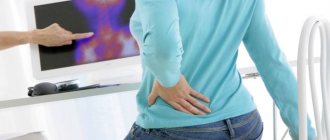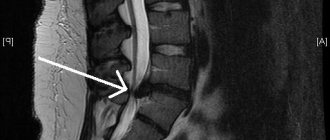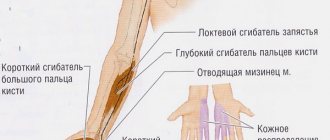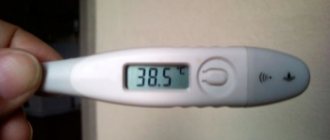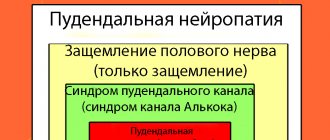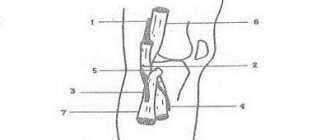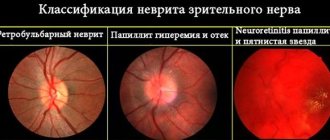Treatment methods for lumbago 1595
Inflammation of the sciatic nerve is a neurological pathology that can be closely associated with degeneration and dystrophy of the cartilage tissue of the intervertebral discs. There are various reasons for the development of this pathology. It causes severe pain that quickly spreads throughout the lower limb on the affected side.
The sciatic nerve is the longest in the human body. It is formed from the lateral branches of the roots L4-L5 and S1-S3. It runs along the tailbone and descends between the muscles of the gluteal region. Inside the piriformis muscle passes to the hip joint, from which it runs along the back of the thigh to the popliteal fossa. It bifurcates into two branches: tibial and fibular. Muscle and articular branches also arise from the sciatic nerve. They are responsible for the innervation of large muscles and joints of the lower limb.
More information about the symptoms and treatment of inflammation of the sciatic nerve can be found in the material provided. The article describes the main causes of its damage, the clinical manifestations of the pathology and the possibilities of effective and safe treatment.
Before treating inflammation of the sciatic nerve, it is necessary to eliminate, if possible, the cause that provoked the appearance of pathological changes. If this is not done, then no treatment, even the most effective one, will allow achieving stable remission and returning all lost functions. Meanwhile, it is important to understand that the sciatic nerve is responsible for the work of many muscles; it ensures normal tone of blood vessels. Therefore, any damage to it leads to negative consequences.
You should not search the Internet for information on how to treat inflammation of the sciatic nerve at home; it is much more productive and safer to consult a neurologist when clinical signs of this pathology appear. This doctor will be able to conduct a full differential examination, make an accurate diagnosis and prescribe effective treatment. Only a doctor can say with certainty how to treat sciatica (inflammation of the sciatic nerve) at home and what caused the onset of this disease.
There are no universal recipes for how to relieve inflammation of the sciatic nerve, since this disease can be associated with a large number of other pathological changes in the human body. Some people lack B vitamins and magnesium in their diet, others need to develop the muscles surrounding the sciatic nerve, and still others need help eliminating scar tissue deformations along the path of this nerve.
In this regard, the first thing to do in case of inflammation of the sciatic nerve is to seek medical help. The cause of this pathology may be too serious and require immediate medical attention. For example, with the development of cauda equina syndrome or spinal canal stenosis, inflammation of this structure may be a signal that total degeneration of the nerve fiber is occurring. If emergency medical intervention is not carried out, a person may become paralyzed or lose the natural functions of bowel movements and bladder.
Sciatic nerve: inflammation - symptoms, treatment
What is inflammation of the sciatic nerve, what is it, what are the causes, symptoms and treatment, prognosis and prospects for the patient?
Some people call this disease:
- senile rheumatism,
- chondrosis,
- osteochondrosis,
- radiculitis.
Like when older people grab their lower back, can’t straighten up and have one leg pulled. This is a classic case, but the fact is that in fact, such a disease can manifest itself in people not only of middle age, but also of young people - even in twenty-year-old patients!
Sciatica: what is it?
Inflammation in the sciatic nerve is also called sciatica; at its core, it is a pinched nerve condition that causes acute pain. It is easy to distinguish the disease from other conditions - one-sided localization (one leg and buttock hurts, from the back to the heel).
Sciatic nerve: where is it located?
The pain is localized along the route of the nerve trunk, which in thickness can be compared to an ordinary white cord with a diameter of a ballpoint pen. The route starts from the lumbosacral spine, goes along the buttock, descends along the outer back surface of the thigh, where it bifurcates in the area of the knee, passes along the back of the lower leg and breaks up from the heel into a whole network of small nerve trunks going to the toes.
It should be noted that the sciatic nerve is the largest and longest nerve in the human body.
Inflammation of the sciatic nerve: causes
Knowing the possible causes of the disease, we can prevent the disease. The most common causes of pinched nerve:
- intervertebral hernia (the vertebrae are compressed, squeezing the nucleus pulposus beyond the fibrous ring, which is necessary for shock absorption of the spine in motion). As a result, this protrusion begins to put pressure on blood vessels and nerves, including pinching the sciatic nerve. In this case, treatment will be difficult, since sciatica occurs only in advanced stages of spina bifida;
- osteochondrosis (chondrosis) or arthrosis, that is, the formation of bone growths on the vertebrae, which also compress the nerves when the spinal column turns;
- displacement of the vertebrae due to injury or congenital anomaly of the spine;
- untreated colds, acute respiratory viral infections;
- poisoning;
- diabetes;
- benign and malignant tumors (neoplasms) in the lumbar region;
- hypothermia of the nerve;
- pregnancy, because with an increase in the abdomen, the center of gravity is confused, the load on the lumbar and sacral region increases;
- stress, depression;
- serious illnesses (typhoid, gonorrhea, syphilis, malaria, rheumatism, purulent inflammation);
- curvature of the spine, flat feet;
- even unsuccessful injections in the buttocks.
Typically, the disease appears when several unfavorable factors combine.
Causes of development of lumbosacral radiculitis
The cause of inflammation and pinching of the sciatic nerve can be:
- Intervertebral disc herniation
- Constant increased physical activity
- Osteochondrosis
- Age-related narrowing of the lumen of the spinal canal
- Prolonged hypothermia
- Inflammatory processes in the pelvic organs
- Diabetes
- Poisoning
- Intoxication
- Tendency to thrombosis
- Overweight
- Constipation
- Tumors.
Sciatica is diagnosed as a complication of infectious diseases (rheumatism, influenza, tuberculosis). The most common cause of sciatica is a herniated disc. In this case, pain occurs with sudden movement, bending, lifting something heavy, or falling.
The pain also intensifies with straining, sitting in a deep chair, staying in one position for a long time, coughing and sneezing. I especially note the influence of stress on the occurrence of sciatica.
It has been proven that a person is able to easily tense the muscles of the back and buttocks, but cannot relax them on his own, through an effort of will. Negative experiences lead to their spasm and pinching of the sciatic nerve, and positive emotions help to relax.
The localization of the inflammatory process in sciatica in women and men is different. In men, in 80% of cases the left sciatic nerve is affected, and in women, on the contrary, the process is right-sided.
This is explained by the fact that when men are stressed, the right hemisphere of the brain is activated, which means the left side of the body becomes tense. In women, the left hemisphere works, and the spasm occurs on the right side.
Over a long period of time (for example, a year), only 2-3 attacks may occur, making sciatica difficult to diagnose. Determining the source of pain is also problematic because the patient may not understand exactly where the discomfort occurs.
Sciatica: symptoms
Diagnostic symptoms of sciatica may be:
- pain piercing the lower back, buttock, back of the thigh, calves, reaching the foot and sometimes even the toes;
- a feeling of numbness in the areas described above, a sensation of goosebumps crawling on the skin;
- the pain is sharp, severe, aggravated by physical activity;
- sometimes the legs swell and sweat a lot;
- during attacks of pain, fainting may occur;
- the advanced form is characterized by the absence of lower back pain with numbness of the leg;
- Without treatment, spasmed muscles can atrophy, shorten, and a person cannot bend his leg, twist his foot, or move his toes.
Sciatica: how is it diagnosed?
Usually, pain with sciatica and the patient’s behavior itself indicate the problem, but for the purpose of accurate diagnosis, some studies and tests help. The doctor may prescribe:
- biochemical and clinical analysis of blood and urine to determine inflammation;
- X-ray of the spine in two projections;
- CT for tissue examination;
- test for reflexes of the knee joint, Achilles tendon;
- checking the patient for Lassen's symptom (for the presence of pain in the hip and ankle when lifting the straightened leg upward) and Bonnet (the same, but the doctor himself lifts the limb, without effort on the part of the patient).
Sciatic nerve: how to treat
It is necessary to restore the sciatic nerve in a comprehensive manner, taking into account the degree of damage and the neglect of the pathology. All symptoms are taken into account and treatment is selected accordingly. As a rule, a neurologist combines drug treatment with homeopathy, physiotherapy, therapeutic exercise (PT) and folk remedies.
Drug treatment
To relieve pain and inflammation, drug treatment is primarily used. The following means are used:
- painkillers. For example, analgin and its derivatives with a narrower focus ( tempalgin, baralgin, sedalgin, pentalgin );
- non-steroidal anti-inflammatory drugs (NSAIDs) – diclofenac, ibuprofen, movalis ;
- corticosteroids;
- For pregnant women, many pills are prohibited, so suppositories are more often used .
Sciatic nerve block
Often, traditional treatment with ointments and tablets does not give the desired result, and the patient continues to suffer from constant pain. Then they provide urgent and effective assistance with novocaine and other sciatic nerve blockade. The procedure allows you to block the transmission of pain impulses along nerve endings to the central nervous system (CNS - brain) from the affected area. As a result, the patient receives significant relief, even the complete disappearance of discomfort. But let's remember that this is just temporary pain relief, not treatment.
Sciatic nerve blockade is performed only when:
- too much pain;
- serious inflammatory process;
- deformation of leg muscles, their spasm;
- trophic disorders.
The blockade has contraindications:
- allergies to drugs;
- low blood pressure;
- heart rhythm disturbance;
- myasthenia gravis;
- state of shock;
- pregnancy and lactation;
- chronic liver diseases, severe disruptions in its functioning.
Often, a strong painkiller is used for blockade - lidocaine, novocaine in combination with NSAIDs and steroids. The drugs are injected layer by layer into the tissues surrounding the sciatic nerve, delivering the medicine to the site of inflammation.
There are several methods of administration:
- posterior (the most popular), the patient lies on his stomach, the doctor applies iodine markings on his buttock to determine the location of the nerve, inserts a needle and injects the medicine;
- anterior - the same, but the doctor penetrates the diseased nerve from the front, inserting a needle between the thigh muscles. Due to the risk of damage to a large artery, it is not the most popular method; it is used when the first one is not possible;
- lateral access is used when it is difficult to use the first two.
The procedure is performed by an experienced doctor who knows anatomy well.
Side effects may include:
- nerve damage, which may cause pain to persist and the condition may worsen;
- puncture of blood vessels, in particular, perforation of an artery, which is very dangerous for the patient due to blood loss and hematomas;
- a fracture of the needle, in which part of it may remain in the body and will have to be removed surgically.
Injections for sciatica
The most effective way to treat sciatica is with injections . But it is not recommended to inject drugs directly into the sore buttock (except for blockade, when the medicine is delivered to the site of inflammation), there is a high probability of a reflex increase in pain. More often they use injections into a healthy buttock or intravenous injections.
To treat pinched and inflammation of the sciatic nerve, the following are used:
- NSAIDs, in particular diclofenac derivatives intramuscularly;
- muscle relaxants to relieve spasms, also intramuscularly;
- vitamins and antiplatelet agents intravenously to improve blood circulation and relieve spasms.
Ointment for sciatica
There are effective ointments, gels and balms for the treatment of sciatica; they are used in complex treatment with other remedies. Ointments are not as effective as tablets and injections, but they have a low likelihood of side effects.
Based on the type of ointment, it can be divided into groups:
- homeopathic – for bioregulation ( Trumeel, Zel T );
- distracting - a strong warming effect relieves pain in deep tissues ( Capsicam, Viprosal, Nicoflex, Finalgon );
- chondroprotectors are effective for sciatica caused by osteochondrosis ( Chondroxid, Honda cream, Teraflex M );
- non-steroidal – relieve pain ( Diclofenac, Voltaren, Dicloran, Butadion, Ketoprofen );
- combined - they contain both anesthetics and anti-inflammatory components ( Dolobene ).
Acupuncture
This treatment method came to us from China. If the manipulation is carried out correctly, acupuncture not only relieves pain, but makes it possible to forget about the problem for a long time, provided the course lasts for a long time.
Of course, it is better when acupuncture is performed by a Chinese specialist or a trained, experienced doctor who knows the biologically active points and locations of the nerves, so as not to cause more harm through the intervention.
Osteopathy and manual therapy
Osteopathy is a special science that is designed to force the body to recover without external intervention. It sounds nice, but in the case of sciatica, everything is quite simple - a specialist gives a massage, taking into account the location of the muscles, joints and nerves, helps to relax the muscles that can put pressure on the painful area, and also improve the condition of this part of the body.
As a rule, the doctor asks the patient to either relax or tense certain muscles, counteract his efforts, and rock poorly moving joints.
When the sciatic nerve is inflamed, an osteopath can improve the condition, but completely curing the disease is difficult and takes a very long time, so the technique has not become particularly widespread.
Treatment
Of course, it is necessary to find out the cause of the pathology, and only a doctor can do this. To do this, you need to see a neurologist. He will conduct an appropriate examination, and you may have to undergo an X-ray examination of the spine or a computed tomography scan. If the examination reveals that the cause of the pain is a tumor, then most likely you will have to have surgery. If this is an inflammatory process caused by the above reasons, then treatment comes down to the following procedures.
- Non-steroidal anti-inflammatory drugs (NSAIDs) are prescribed that relieve inflammation and pain - Meloxicam, Nimesulide (Nise, Nimesil), Piroxicam, Ketonal (Ketanov, Ketaprofen), Celebrex. The drugs are prescribed in the form of injections and tablets. For external use, ointments and gels are used.
- To normalize metabolic processes in nerve fibers, B vitamins (combilipen, milgamma) are prescribed;
- Diuretics (furosemide) are used to relieve swelling;
- Physiotherapy in the form of electrophoresis, magnetic or laser effects on the diseased area, paraffin baths;
- Reflexotherapy - acupressure of pain areas for 2-4 minutes helps relieve muscle tension and reduce pain, or Kuznetsov’s applicator;
- Non-traditional methods – hirudotherapy, bee stinging, acupuncture, stone therapy. Prescribed only after the exacerbation has subsided. Mustard, sea, turpentine, salt, fir, spruce, cedar, pine needles are recommended;
- Folk remedies and therapeutic exercises - about them later in the article.
If conservative and physiotherapeutic treatment is ineffective, they resort to surgical intervention—discectomy or microdiscectomy. This is the surgical removal of part or all of the intervertebral disc that is pressing on the sciatic nerve.
It is important to remember that treating inflammation or pinching is a rather long and complex process. Treatment must be comprehensive. The use of folk remedies and therapeutic exercises at home will be a good addition to complex treatment.
Pinched sciatic nerve during pregnancy: treatment
Sometimes pinching occurs during pregnancy, especially in the third trimester due to the pressure of the enlarged uterus, and in some cases at the very beginning of the term. But then, as a rule, the pain goes away on its own after moving the fetus and uterus a little upward.
Sometimes the manifestations of sciatica can be confused with ordinary tension in the lower back muscles due to increased load. You should consult a doctor if:
- the pain does not go away even with rest;
- it is impossible to roll over, bend over, move your legs;
- the process of defecation and urination is disrupted.
Sometimes, when there are complaints, the gynecologist does not offer treatment, fearing the consequences, and simply advises to endure. Of course, you shouldn’t fold your hands; you can ask for help from an osteopath or neurologist who already has experience treating pregnant women and will prescribe safe treatment.
Typically used during pregnancy:
- non-steroidal ointments and creams;
- massage (professional only);
- injections of anesthetics for very severe pain;
- exercises to relax and strengthen muscles, for example, the usual knee-elbow pose for 10-15 minutes;
- warming the sore spot with warm scarves and scarves.
Exercises to strengthen your back muscles
Therapeutic exercises help improve blood circulation in the lumbar spine and strengthen the back muscles. Do back exercises; these exercises promote blood flow to the back muscles, and from there the blood will diffusely move to the intervertebral discs and nourish them. This will help restore the structure of cartilage tissue, relieve inflammation and congestion. Before doing these exercises, consult your doctor. He will tell you which exercises are best to do and during which period of illness.
I suggest you watch the seminar of exercise therapy doctor Alexandra Bonina “Pinceration of the sciatic nerve” by clicking on this link:
Dear readers, today you learned the causes of lower back pain, methods of treating pinched sciatic nerve. Of course, to avoid pain, take care of yourself - don’t lift weights, don’t catch a cold, don’t be nervous, do back exercises. If you experience such exacerbations, then during the interictal period, undergo a course of sanatorium-resort treatment. Baths, mud, massage, etc. will help you recover faster. And be healthy!
How to treat sciatic nerve at home
To help traditional medicine, you can use folk methods to combat the problem at home.
So, a pinched nerve is well treated with decoctions:
- Horse sorrel seeds . To do this, pour 2 teaspoons of the product into 5 liters of boiling water, heat in a water bath for 10 minutes, strain and drink instead of tea before meals;
- Burdock root . For 1 tablespoon you need to take 1 cup of Cahors, heat over low heat for 5-6 minutes, strain, drink in the morning and evening;
- Calendula flowers . 1 tablespoon per cup of boiling water, boil for a couple of minutes, drink a quarter glass 3-4 times a day.
Baths with a decoction of horseradish roots and pine twigs (about 1 kg of product per bath) are also effective.
At home, you can prepare an effective remedy - rubbing - according to this recipe: 10 analgin tablets , ground into powder, 1 glass of vodka , a couple of drops of iodine , leave for 3 days, lubricate the sore spot and wrap it in wool.
Compresses are good, for example: grate a raw potato , collect the juice from it, add 1 teaspoon of kerosene , moisten gauze with the composition and apply to the sore back. Before doing this, lubricate the skin with vegetable oil to avoid burns.
At home, without the use of medications, it is rarely possible to completely get rid of the problem of an inflamed seat.
Exercises for pinched sciatic nerve
When a nerve is pinched and inflamed, exercise therapy (therapeutic physical education) is indicated - therapeutic gymnastics, it helps to unblock the pinched nerve trunk and remove swelling, pain, speed up metabolic processes, and relieve muscle spasms. Ideally, the first classes should be conducted with an experienced exercise therapy instructor in a hospital, but only after the first pain has been relieved.
The most useful exercises:
- lying on your back, pull your knees to your stomach, return to the starting position, repeat;
- standing on your knees and hands, alternately bend and arch your back;
- perform the “bicycle” exercise;
- lying on your stomach, stretch your arms in front of you, lift your body and stretch your neck.
Massage for pinched sciatic nerve
A good, properly conducted course of massage is very effective in combating pinched sciatic nerves, although it should be performed by an experienced massage therapist.
With a good massage and the work of a chiropractor to unblock pinched nerve trunks, pinched nerves can be cured and the pain completely relieved!
Other treatments
If you cannot get rid of inflammation of the sciatic nerve using traditional therapy and rubbing at home, the disease progresses, the pain does not go away and muscle deformation occurs with numbness of the leg - you need to resort to the last, most radical method, that is, surgery.
Nowadays, doctors more often use minimally invasive methods, for example, microdiscectomy using fiber-optic equipment. If the doctor is experienced and the operation is successful, then the prognosis is quite optimistic.
Occasionally, the following is also used to relieve sciatica pain:
- magnetic therapy,
- UHF,
- electrophoresis,
- paraffin compresses,
- phonophoresis.
Side effects of medications
Not all medications are effective. There are some that can have negative consequences for the patient’s body.
For example, if a medication to treat sciatica is taken with food, its effectiveness will be reduced. In addition, blood pressure increases. Therefore, experts do not recommend the use of medications for patients who often experience hypertensive problems.
During the period of taking medications, fluid stagnates in the body, which leads to edema. Side effects from medications also include drowsiness, frequent headaches, and general deterioration in health.
The use of any medications must be agreed with a specialist. Otherwise, complications may arise that will be even more dangerous than the original disease.
Long-term use of drugs such as NSAIDs leads to disturbances in the digestive system. An ulcer may form that is difficult to treat and thus becomes chronic over time.
In addition, anti-inflammatory non-steroidal drugs cannot always cope with the task. If the patient is additionally taking medications that thin the blood, then NSAIDs should not be used.
Steroid medications help well in the fight against the inflammatory process that accompanies the pathology, but at the same time, they have a number of side effects. These include a decrease in the functioning of the immune system and problems associated with the digestive system. The patient rapidly gains weight, the body's hormonal levels are disrupted, osteoporosis develops, and edema appears.
Prevention of sciatica
How to prevent nerve inflammation:
- dress according to the weather, avoid exposing the lower back, as the nerves and spine do not like the cold;
- play sports, for example, swimming, yoga, Pilates;
- to live an active lifestyle;
- avoid excessive physical activity;
- Maintain correct posture both when walking and sitting.
So we looked at inflammation of a pinched sciatic nerve, its symptoms and treatment, features of manifestation, causes and methods of prevention.
Video on the topic
Pinched sciatic nerve - eliminate pain in 2 minutes!
On the video channel "Osteomed".
Does your lower back hurt and radiate to your leg? Most often these are symptoms of a problem with the sciatic nerve. It seems scary - but it can be removed with just one exercise! We try and get rid of the pain.
Unblocking the Sciatic Nerve: Treatment
On the video channel “Russian Fitness Workout”.
Sciatica neuralgia (sciatica) is a more or less pronounced feeling of pain in the leg caused by irritation of the sciatic nerve. Often pain is felt on only one side of the body.
“Pseudo-sciatica” (false sciatica), which causes symptoms similar to compression of the nerve endings of the spine, is caused by compression of the peripheral nerves, usually due to tension of the piriformis muscle (piriformis syndrome) or other muscles of the thigh.
What to do for inflammation of the sciatic nerve: treatment?
On the video channel “Nikolay Vysochanskiy”.
Inflammation of the sciatic nerve can occur suddenly after severe hypothermia, or develop gradually as a result of many years of stress associated with sedentary work, injuries, sudden lifting of heavy objects, or problems with the pelvic organs.
Severe pain does not allow you to ignore the inflammation that has arisen and sharply reduces motor abilities. A number of restrictions arise that reduce the quality of life. At such moments, internal panic may arise about how to live further...
And then it is very important to realize the need to constantly take care of the health of your spine.
If you still have the ability to independently perform special exercises, you should not hesitate. You need to seek qualified help.
In this video, made during a lesson by Nikolai Vysochansky, you will learn about the method of restoring health in case of inflammation of the sciatic nerve.
Just two exercises eliminate acute lower back pain in just 5 minutes
On the video channel “Your Health”.
In this video, Evgeny Engels (neurologist, manual therapy doctor at the Echinacea Clinic) shows two easy and simple exercises, and most importantly, these exercises will not harm the spine. These exercises can eliminate acute pain in the lower back and remove muscle spasms. Just 5 minutes a day of exercise will help quickly eliminate acute pain in the lumbar region.
Source: edition of the article by Svetlana Malysheva taken from the site https://blog-dm.ru/vospalenie-sedalishchnogo-nerva-simptomy-i-lechenie/
Preventive measures
The muscle corset must be kept in good shape. The weakening of the holding capacity of the muscles leads to the displacement of various organs (the spine ceases to function as a supporting column of the body). And as a result, the sciatic nerve becomes inflamed.
Therefore, it is necessary to take care of your health; following these recommendations will help you fight sciatica:
- balanced diet (the presence of magnesium and potassium in foods is mandatory for the diet);
- physical activity, sports;
- approaches to the horizontal bar for stretching intervertebral discs;
- posture correction from a young age;
- attending manual therapy sessions;
- We imitate animals - arching the back on all fours.
An inflamed sciatic nerve can cause a person a lot of trouble, pain and negative health effects in general. Do not hesitate to contact a doctor at the first symptoms that indicate inflammation of the sciatic nerve; this will help to promptly treat the pathology.

